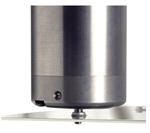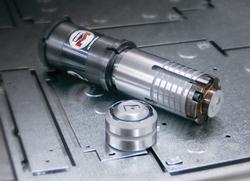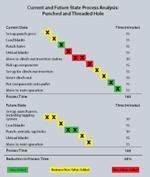Contributing Writer
- FMA
- The Fabricator
- FABTECH
- Canadian Metalworking
Categories
- Additive Manufacturing
- Aluminum Welding
- Arc Welding
- Assembly and Joining
- Automation and Robotics
- Bending and Forming
- Consumables
- Cutting and Weld Prep
- Electric Vehicles
- En Español
- Finishing
- Hydroforming
- Laser Cutting
- Laser Welding
- Machining
- Manufacturing Software
- Materials Handling
- Metals/Materials
- Oxyfuel Cutting
- Plasma Cutting
- Power Tools
- Punching and Other Holemaking
- Roll Forming
- Safety
- Sawing
- Shearing
- Shop Management
- Testing and Measuring
- Tube and Pipe Fabrication
- Tube and Pipe Production
- Waterjet Cutting
Industry Directory
Webcasts
Podcasts
FAB 40
Advertise
Subscribe
Account Login
Search
Getting creative with punch tooling
- By Andy Spence-Parsons
- April 15, 2008
- Article
- Punching and Other Holemaking
Many fabricators are adopting lean manufacturing techniques to gain a competitive advantage in today's global marketplace. A central element of the lean philosophy is the relentless, systematic, and continuing elimination of waste. The key word is continuing. Starting down the lean manufacturing path and staying on it are different things, as many metal fabricators are discovering.
If you do quite a bit of punching, you might find that, through the creative use of tooling, you can sustain the lean journey, one fabricating project after another.
Going Lean
In a recent FabCast presentation by the Fabricators & Manufacturers Association, International®, waste was described as "any element in the conversion of raw material to finished product that does not add value, and which the customer is not prepared to pay for." It follows that the elimination of waste reduces costs and improves the bottom line.
Lean practitioners often highlight eight deadly wastes:
- Excess inventory
- Overproduction
- Overprocessing
- Rework/defects (scrap)
- Transportation
- Waiting
- Motion
- Underutilized people
Analyze. When seeking to eliminate waste, many companies begin by evaluating each step in a particular process by using a value stream map or a process map. During this evaluation they examine every step to determine if it is:
- Value-added
- Business non-value-added (any essential task that does not add value, but has to be done)
- Non-value-added (any task that does not add value)
Implement. The next step is to "lean out" the process, or to re-engineer the process to eliminate as much of the non-value-added content as possible. In many cases, a simple change in the manufacturing process will result in huge improvements in productivity and performance.
The most creative ideas come from cross-functional teams—groups that are made up of employees from various disciplines, such as machine operators, engineers, and maintenance personnel. These groups also often include external resources, such as tooling suppliers and machine vendors. Cross-functional teams are particularly successful because participants who are not normally involved in the production process are more likely to ask not-so-obvious questions that may lead to a breakthrough solution.
Creative, out-of-the-box thinking by cross-functional teams, combined with innovative technologies, can go a long way in improving throughput, eliminating waste, and increasing profitability.
Practical Tooling Examples. The following two examples demonstrate a typical lean trade-off: investing in additional tooling but removing non-value-added steps from a fabrication process.
The first example is a simple component with threaded holes.

Figure 1A tapping tool, loaded into a punch press's autoindex station, cuts threads into punched or extruded holes.
- In the current state, the threaded holes are created by piercing holes in the punch press, then installing self-clinching fasteners in a secondary operation.
- In the future state, the hole is made by one tool and tapped by another on the punch press (see Figure 1). The hole, which can be punched or extruded, is made by a tapping tool installed in the punch press's autoindex station. Both operations—making the hole and threading it—are accomplished with a single setup on a single machine, thus eliminating setup, wasted transport, waiting time, and motion.
A process chart (see Figure 2) demonstrates that the future state reduces the process time from 160 minutes to 105 minutes.
The second example is a simple electrical enclosure.
- In the current state, the component is punched with a punch press, then formed on a press brake, welded, cleaned, and painted.
- In the future state, the material is changed to precoated steel, and the welded corner joints are replaced by fabricated joints which, when snapped together, lock in place.
Again, the process chart demonstrates that the change has eliminated some non-value-added time and drastically reduced lead-time (see Figure 3).
The joint tooling assembly eliminates expensive and time-consuming secondary operations such as spot welding, riveting, and fastening with threaded hardware. It is suitable for materials of dissimilar type or thickness and ideal for prefinished materials.
A self-locking, spring-loaded tab that snaps securely into a prepunched hole is the ideal method. The small button in the top of the form is semisheared to provide a positive mechanical lock when engaged with a hole in the receiving tab (see Figure 4).
In both examples, re-engineering the process removed several sources of waste—the time associated with material handling, transportation, and waiting, and the damage that occasionally results from material handling and transportation. It had additional benefits, too, in that it improved the part quality and consistency.
About the Author
Andy Spence-Parsons
1295 Lund Blvd.
Anoka, MN 55303
800-328-4492
Related Companies
subscribe now

The Fabricator is North America's leading magazine for the metal forming and fabricating industry. The magazine delivers the news, technical articles, and case histories that enable fabricators to do their jobs more efficiently. The Fabricator has served the industry since 1970.
start your free subscription- Stay connected from anywhere

Easily access valuable industry resources now with full access to the digital edition of The Fabricator.

Easily access valuable industry resources now with full access to the digital edition of The Welder.

Easily access valuable industry resources now with full access to the digital edition of The Tube and Pipe Journal.
- Podcasting
- Podcast:
- The Fabricator Podcast
- Published:
- 04/16/2024
- Running Time:
- 63:29
In this episode of The Fabricator Podcast, Caleb Chamberlain, co-founder and CEO of OSH Cut, discusses his company’s...
- Trending Articles
AI, machine learning, and the future of metal fabrication

Employee ownership: The best way to ensure engagement

Dynamic Metal blossoms with each passing year

Steel industry reacts to Nucor’s new weekly published HRC price

Metal fabrication management: A guide for new supervisors

- Industry Events
16th Annual Safety Conference
- April 30 - May 1, 2024
- Elgin,
Pipe and Tube Conference
- May 21 - 22, 2024
- Omaha, NE
World-Class Roll Forming Workshop
- June 5 - 6, 2024
- Louisville, KY
Advanced Laser Application Workshop
- June 25 - 27, 2024
- Novi, MI




























